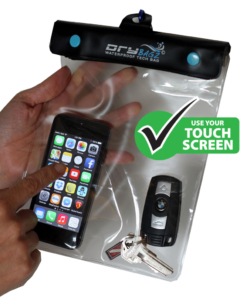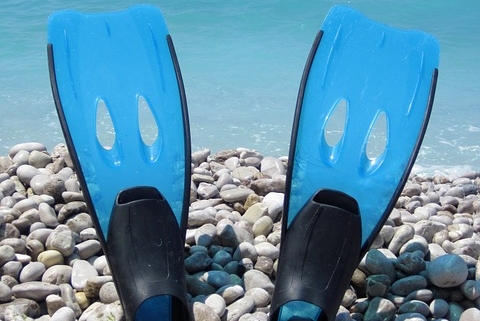Want to know the secret to having a safe and enjoyable dive? It’s bringing the right items. While most divers know the importance of bringing a wetsuit, mask, regulator and gas tank, there are other essential items that you shouldn’t ignore. Regardless of when and where you’re planning to dive next, the five following essentials will promote a safer and more enjoyable diving experience.
#1) Underwater Camera
 You’ll encounter a wide variety of marine life when diving, some of which may include fish, mollusks, turtles, squid, sharks, jellyfish, dolphins and even whales. Without a waterproof camera, though, you won’t be able to capture these moments on film. You can always make a written note of the marine life you enter when diving on a dive log, but there’s no substitution for capturing these memories on film.
You’ll encounter a wide variety of marine life when diving, some of which may include fish, mollusks, turtles, squid, sharks, jellyfish, dolphins and even whales. Without a waterproof camera, though, you won’t be able to capture these moments on film. You can always make a written note of the marine life you enter when diving on a dive log, but there’s no substitution for capturing these memories on film.
Of course, you can’t use just any camera to take photos of marine life when diving. Unless it’s a waterproof camera that’s designed specifically for underwater usage, it will almost certainly sustain damage. Underwater cameras have been around since the 1960s, during which French diver and underwater explorer Jacques Cousteau helped develop the Calypso. Since then, countless other underwater cameras have been released.
#2) Scuba Fins
Don’t forget to bring a pair of high-quality scuba fins on your next diving trip. Also known as swim fins, scuba fins are fin-like accessories that you wear on your feet when diving or swimming. They are typically made of soft materials like rubber, carbon fiber or plastic, which allow them to flex as you kick your feet.
The purpose of wearing scuba fins is to improve your ability to swim through the water. As humans, our feet are too small — and not the right shape — to effectively propel our bodies through the water. You can achieve some level of propulsion and momentum when kicking your feet, but you’ll use a lot of energy while covering little ground (or water) in the process. And because kicking your bare feet consumes so much energy, you’ll expend your gas supply more quickly.
Scuba fins offer a solution to this problem by making your kicks more efficient. When wearing them, you’ll create more propulsion with your kicks, so remember to bring scuba fins on your next driving trip. If you’re familiar with scuba fins, you should already know how to wear them use.
There are two primary types of scuba fins, including the following:
- Bifins: The most common type, bifins consist of a pair of long and narrow fins. Bifins are popular among swimmers and divers because they are simple and easy to use. You place each of your feet in one of the two fins, after which you kick your feet to propel yourself through the water.
- Monofins: On the other hand, monofins consist of a single large fin that features two pockets for your feet. When wearing monofins, you’ll be forced to keep your feet together at all times. Freedivers often prefer monofins over bifins because they allow for faster and more efficient ascensions as well as descension.
If you’re a newcomer to the sport of diving, though, try to keep your legs straight when kicking. If you bend your knees, you’ll exhaust a greater amount of energy. For fast and efficient kicking while wearing scuba fins, twist your hips while kicking your feet in a flutter-like motion.

#3) Waterproof Bag
You should also bring a waterproof bag on your next diving trip. Why is this an essential diving item exactly? Well, you’ll be obviously be surrounded by water when diving, and if you want to bring electronics or other non-waterproof items, you’ll need some type of waterproof accessory in which to store them. A waterproof bag solves this problem by offering a safe and secure area in which to store your items. Whether you’re sitting on the beach or taking a boat to your dive site, you can rest assured knowing that your items won’t sustain damage from water exposure. A waterproof bag creates an airtight seal that keeps water out, thereby protecting the contents from damage.
Some waterproof bags will even allow you to use your smartphone while it’s stored inside. As shown to the left, the Wateproof Dry Tech Bag sold here at Dive Logz is completely waterproof, yet it still allows you to use your smartphone. This is in stark contrast to most other waterproof bags. With other waterproof bags, you’ll have to take your smartphone out to use it.
That’s just one of many reasons to choose the Waterproof Dry Tech Bag. Not only does it support smartphone usage; it comes with a lanyard as well. Using the lanyard, you can wear the Waterproof Dry Tech Bag around your neck so that you don’t lose or misplace it.
#4) Water-Resistant Dive Log Book
In addition to a waterproof bag, remember to bring a water-resistant dive log book. As may already know, a dive log book is a binder in which you store your dive logs. Rather than carrying “loose” dive logs, you can store them in a book. But not all dive log books are water-resistant. Some offer little or no protection against water. If you happen to store your dive logs in one of these non-water-resistant books, they may succumb to damage. As water makes its way onto your dive logs, it can smear the ink, making your entries illegible. So, always store your dive logs in a water-resistant log book.
When your dive logs are stored in a water-resistant log book, small amounts of water won’t harm your dive logs. If a large wave happens to crest in front of your boat, your dive logs will remain dry. Some water-resistant dive log books contain other features besides a water-resistant design. The Scuba Diving Log Binders, for example, feature various compartments for cards, pens and other small items. And if you order your Scuba Diving Log Binder now, you’ll receive 50 free dive logs at no additional charge, which you can use to fill your new water-resistant dive log book.
#5) Diving Gloves
Why should you bring diving gloves on your next dive trip? While they aren’t necessarily as important as a wetsuit or regulator, this otherwise simple diving accessory offers several noteworthy benefits. When wearing a pair of high-quality diving gloves, your hands will be protected from injury. It’s not uncommon for divers to cut their hands on coral, sharp rocks, shipwrecks, fishing lures or even their own equipment. If you happen to cut yourself underwater, you’ll have to resurface to seek treatment, meaning a shorter and less-enjoyable dive. A pair of diving gloves, however, will protect your hands from cuts and scrapes.
Another benefit of wearing diving gloves is that they keep your hands warm. You won’t always have the luxury of diving in 90-degree waters. Depending on the region and day of year in which you go diving — as well as your depth — the waters may be as cool as 70 degrees. A wetsuit will insulate your body to protect your torso, arms and legs from the cold water, but your hands will likely be exposed. Thankfully, diving gloves add an insulating layer of protection over your hands, allowing you to comfortably dive in cold waters.
Pick up your essential Drybagz and Water-Resistant Log Book today!



